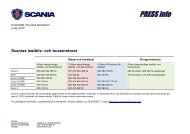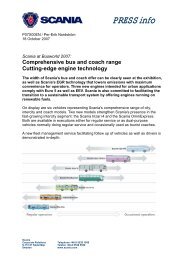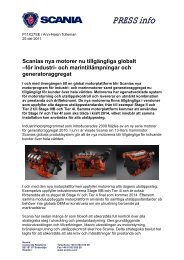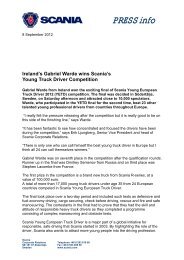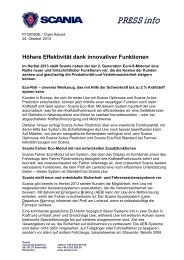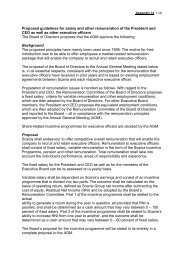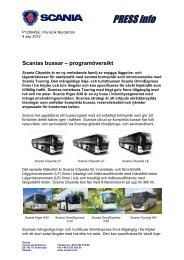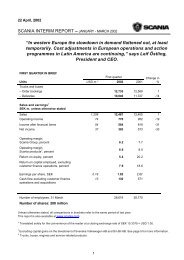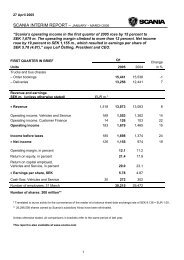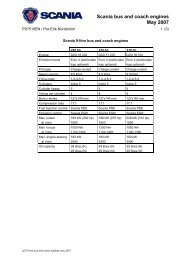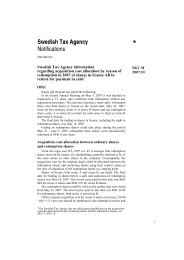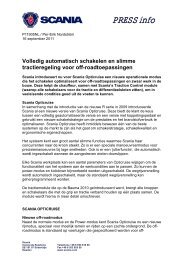Scania annual report 2003
Scania annual report 2003
Scania annual report 2003
You also want an ePaper? Increase the reach of your titles
YUMPU automatically turns print PDFs into web optimized ePapers that Google loves.
NOTE 33 Financial instruments and financial risk management<br />
Assets and liabilities of a financial nature occur mainly in the Customer<br />
Finance segment, and to a lesser extent in Vehicles and Service.<br />
Financial assets occur mostly as a consequence of long- and shortterm<br />
financing of customers’ vehicle purchases and of the Group’s<br />
projected liquidity requirements. Financial liabilities have been incurred<br />
mainly in order to fund the Customer Finance segment’s lending and<br />
leasing to customers and, to a lesser extent, to fund capital employed<br />
in Vehicles and Service.<br />
<strong>Scania</strong> uses derivative instruments, mainly for the purpose of:<br />
• transforming corporate-level borrowings in a limited number of<br />
currencies to those currencies in which the respectively funded<br />
assets are denominated,<br />
• transforming the interest rate refixing period for funding to the interest<br />
rate refixing period in the Customer Finance loan and lease portfolio,<br />
as well as the desired interest rate refixing period for funding of other<br />
assets,<br />
• hedging future cash flow for Vehicles and Service from undesired<br />
currency risk and<br />
• to a lesser extent, converting projected surplus liquidity in foreign<br />
currencies to SEK.<br />
Financial risk management in the <strong>Scania</strong> Group<br />
In addition to business risks, <strong>Scania</strong> is exposed to various financial<br />
risks in its operations. The financial risks that are of the greatest importance<br />
are currency-, interest rate-, refinancing- and credit risks. Credit<br />
risk related to customer commitments is managed, within established<br />
limits, on a decentralised basis by means of local credit assessments.<br />
Other risks are managed at corporate level by <strong>Scania</strong>’s treasury unit, in<br />
compliance with the financial policy adopted by <strong>Scania</strong>’s Board of Directors.<br />
For the purpose of promoting long-term profitability, this financial<br />
policy states that financial risks shall be minimised and access to liqui-<br />
Hedging of currency flows<br />
dity shall be safeguarded. On a daily basis, the corporate treasury unit<br />
measures the risks of outstanding positions, which are managed within<br />
established limits in compliance with the financial policy.<br />
Currency risk<br />
Currency risk is the risk that changes in currency exchange rates<br />
will adversely affect cash flow. Changes in exchange rates also affect<br />
<strong>Scania</strong>’s income statement and balance sheet as follows:<br />
– Earnings are affected when income and expenses in foreign currencies<br />
are translated to Swedish kronor.<br />
– The balance sheet is affected when assets and liabilities in foreign<br />
currencies are translated to Swedish kronor.<br />
More than 90 percent of <strong>Scania</strong>’s sales occur in countries outside Sweden.<br />
Since a large proportion of production occurs in Sweden, at costs<br />
denominated in Swedish kronor, the <strong>Scania</strong> has large net inflows of foreign<br />
currencies. During <strong>2003</strong>, total net revenue in foreign currencies<br />
amounted to about SEK 18 billion. The largest currencies were EUR and<br />
GBP. Note 31 shows <strong>Scania</strong>’s net revenue in the most commonly occurring<br />
currencies.<br />
Based on the geographic distribution of revenues and expenses<br />
during <strong>2003</strong>, a one percentage point change in the Swedish krona<br />
against other currencies, excluding currency hedging, has an impact<br />
on operating income of about SEK 180 m. on an <strong>annual</strong> basis.<br />
<strong>Scania</strong>’s policy is to hedge its currency flows during a period of<br />
time equivalent to the projected orderbook until the date of payment.<br />
However, the hedging period is allowed to vary between 0 and 12<br />
months. Hedging of currency risks mainly occurs by selling currencies<br />
on forward contracts, but also by means of currency options.<br />
The effect of currency derivatives on operating income totalled<br />
SEK 620 m. (500), of which SEK 54 m. (39) was related to still unexpired<br />
GBP/SEK EUR/SEK KRW/SEK CHF/SEK NOK/SEK ZAR/SEK AUD/SEK<br />
Quarter Volume Rate* Volume Rate* Volume Rate* Volume Rate* Volume Rate* Volume Rate* Volume Rate*<br />
Q 1** 2004 25 13.318 95 9.306 10,000 0.0067 10 6.105 80 1.109 80 1.1604 13 5.375<br />
Q 2 2004 155 9.182 17 6.035 26 1.092<br />
Q 3 2004 125 9.220 18 6.000<br />
Q 4 2004 165 9.105<br />
Total (in millions) 25 13.318 540 9.189 10,000 0.0067 45 6.037 106 1.105 80 1.1604 13 5.375<br />
Closing day rate<br />
031231 12.913 9.094 0.006 5.828 1.081 1.09 5.432<br />
Unrealised gain/loss<br />
031231 11.3 22.4 6.2 3.9 2.5 6.9 –0.4<br />
* Average forward price and lowest redemption price for currency options.<br />
** January volumes are not included, since the unrealised gain/loss effect was <strong>report</strong>ed in December.<br />
contracts that were offset on the balance sheet date by net assets in<br />
the balance sheet. The value of outstanding contracts not recognised<br />
in earnings which will affect 2004 earnings can be seen in the table<br />
“Hedging of currency flows.”<br />
At the end of <strong>2003</strong>, <strong>Scania</strong>’s net assets abroad amounted to<br />
SEK 10,140 m. (11,397), see Note 30. The net assets of foreign subsidiaries<br />
are normally not hedged. To the extent subsidiaries have significant<br />
net monetary assets in local currency, however, they may be<br />
hedged. At year-end <strong>2003</strong>, SEK 346 m. (566), equivalent to 3 (5)<br />
percent, mainly attributable to Europe, were hedged.<br />
Interest rate risk<br />
Interest rate risk is the risk that changes in market interest rates will<br />
adversely affect cash flow. Changes in market interest rates may also<br />
affect the fair value of the loan portfolio. <strong>Scania</strong> is exposed to interest<br />
rate risk on the asset side, as a consequence of financing of customers,<br />
which mostly occurs in Customer Finance. Net debt, i.e. borrowings<br />
less liquid assets, also exposes the <strong>Scania</strong> Group to interest rate risk.<br />
For <strong>Scania</strong>’s asset and liabilities that carry variable interest rates, a<br />
change in market interest rates has a direct effect on cash flow, while for<br />
fixed-interest assets and liabilities, the fair value of the portfolio is instead<br />
affected when market rates change. To manage interest rate risks, the<br />
Group mainly uses interest rate swaps and interest rate options.<br />
Borrowing in Vehicles and Service is mainly used for funding of<br />
working capital, which means that a short interest rate refixing period<br />
matches the turnover rate of working capital. <strong>Scania</strong>’s policy concerning<br />
interest rate risks in the Vehicles and Service segment is that the interest<br />
rate refixing period on its loan portfolio should normally be 6 months,<br />
but that deviations are allowed in the range between 0 and 24 months.<br />
At year-end, the loan portfolio in Vehicles and Service amounted to<br />
SEK 4,427 m. and the average interest rate refixing period was about<br />
3 (2) months.<br />
Given the same loan liabilities and interest rate refixing period as<br />
at year-end <strong>2003</strong>, a change in market interest rates of 100 basis points<br />
(1 percentage point) would change the interest expenses in Vehicles<br />
and Service by about SEK 35 m. on an <strong>annual</strong> basis. Due to the short<br />
interest rate refixing period, the fair value of the loan portfolio would<br />
not be significantly affected.<br />
<strong>Scania</strong>’s policy regarding interest rate risks in the Customer Finance<br />
segment is that lending and borrowing should match in terms of<br />
interest rates and maturity periods. Interest rate refixing related to the<br />
credit portfolio and borrowing had the following structure as per<br />
31 December <strong>2003</strong>:<br />
71 ANNUAL REPORT <strong>2003</strong>



